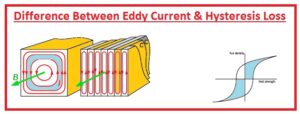 Hello, friends, I hope you all are doing great. In today’s tutorial, we will discuss the Difference Between Eddy Current & Hysteresis Loss. The basic difference between eddy current and hysteresis is that relative motion among the conductor and magnetic field causes eddy current losses. While hysteresis loss occurs due to the retaining process of a field in the core when external supply is off.
Hello, friends, I hope you all are doing great. In today’s tutorial, we will discuss the Difference Between Eddy Current & Hysteresis Loss. The basic difference between eddy current and hysteresis is that relative motion among the conductor and magnetic field causes eddy current losses. While hysteresis loss occurs due to the retaining process of a field in the core when external supply is off.
In today’s post, we will have a detailed look at both eddy current and hysteresis losses with the detailed compare them to find their differences. So let’s get started with Difference Between Eddy Current & Hysteresis Loss.
Difference Between Eddy Current & Hysteresis Loss
Eddy Current
- These power losses exit due to relative movement among the core and flux in the core.
- The formula for eddy current is given as.
Pe = Ke x Bmax2 x f2 x t2 x V
- This loss occurs when there is an interaction between the conductive material and flux exits.
- It can be decreased with the use of the thin laminated core.
- These current are moved in the closed path created through conductive meters and have a field at ninety degrees.
- These current can be effect the close object that phenomenon work in transform
- The eddy current strength in any material relies on some factors like conductor length, field, area, and flux varying rate.
- The field created by the eddy current disturbs the source that creating the field according to Lenz law.
- In the conductive material having 0 resistivity value will produce heat due to eddy current. With that, they produce electromagnetic force
- The heat used for the induction heating process
- Eddy current caused the production of the skin affect the conductive materials. Also, produce proximity effect
Hysteresis Loss
- These losses occur due to the reversal phenomena of magnetism in the core of instruments like a transformer, generator.
- It also demagnetization and magnetization of the core of the transformer through the external field.
- With the magnetizing process increase flux rises.
- Its formula is given as.
Pb = η x Bmaxn x f x V
- It occurs when there is a magnetized core like transformer core and after removal of input supply, there is some magnetism occurs in the core.
- It can be reduced with the use of core created with the silicon steel that gets demagnetized as supply is off.
That is a detailed post about the difference between eddy current losses and hysteresis losses if you have any query ask in comments. Thanks for reading.






